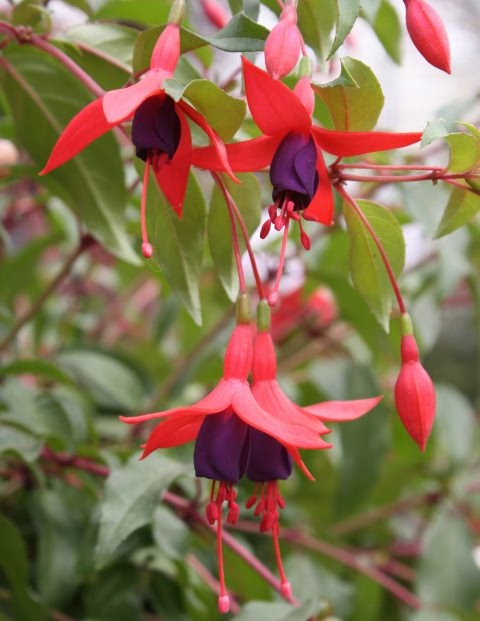
Angel Earrings Cascading Fuchsia
Botanical Name
:
Fuchsia ‘Sanihanf’
Plant Type
:
Subshrub annual
Seasons
:
Autumn, Spring, Summer
Sun Level
:
Partial shade (2–5 hours of indirect sunlight)
Ideal Soil Temperature for Planting
:
60–75°F (15–24°C)
Soil Type
:
Well-draining soil, tolerates poor draining soil
Germination
:
Usually propagated through cuttings rather than seeds. Seeds take 1–4 months to germinate, while cuttings develop roots in 6–8 weeks, making them the preferred method for quicker growth.
P.H. Level
:
6.0–6.5
Water/Irrigation
:
Keep soil consistently moist but not waterlogged; prefers well-draining soil
Fertilization
:
Water it uniformly throughout its life with a 200 ppm liquid nitrogen fertilizer and change to a higher potash feed as buds become visible.
Habit
:
Trailing, cascading
Final Plant Height
:
15–20 inches
Spread
:
20–28 inches
Flowers
:
Bell-shaped, vibrant pink, purple, and red blooms/Purple and red blooms in fall and summer
Attracts
:
Hummingbirds, butterflies, and bees
Uses
:
Border plant, compact, container plant, cutting garden, long-blooming
Companions
:
Begonias, impatiens, Coleus
Pruning
:
Prune in late winter or early spring to encourage bushier growth and more blooms. Prune it back to ⅓ when blooming slows down to help push out a new round of blooming.
Toxicity
:
Non-toxic to humans but mildly toxic to pets if ingested
Pests
:
Lookout for whiteflies, thrips, aphids, leaf miners, red spider mites, snails and slugs
Diseases
:
Take preventive measures against Botrytis, Thielaviopsis, Powdery Mildew, Phytophthora, and Pythium
Additional Info
:
Angel Earrings Cascading Fuchsia doesn’t like very hot and humid conditions and may stop blooming in extreme heat.
Botanical Name
:
Fuchsia ‘Sanihanf’
Plant Type
:
Subshrub annual
Seasons
:
Autumn, Spring, Summer
Sun Level
:
Partial shade (2–5 hours of indirect sunlight)
Ideal Soil Temperature for Planting
:
60–75°F (15–24°C)
Soil Type
:
Well-draining soil, tolerates poor draining soil
Germination
:
Usually propagated through cuttings rather than seeds. Seeds take 1–4 months to germinate, while cuttings develop roots in 6–8 weeks, making them the preferred method for quicker growth.
P.H. Level
:
6.0–6.5
Water/Irrigation
:
Keep soil consistently moist but not waterlogged; prefers well-draining soil
Fertilization
:
Water it uniformly throughout its life with a 200 ppm liquid nitrogen fertilizer and change to a higher potash feed as buds become visible.
Habit
:
Trailing, cascading
Final Plant Height
:
15–20 inches
Spread
:
20–28 inches
Flowers
:
Bell-shaped, vibrant pink, purple, and red blooms/Purple and red blooms in fall and summer
Attracts
:
Hummingbirds, butterflies, and bees
Uses
:
Border plant, compact, container plant, cutting garden, long-blooming
Companions
:
Begonias, impatiens, Coleus
Pruning
:
Prune in late winter or early spring to encourage bushier growth and more blooms. Prune it back to ⅓ when blooming slows down to help push out a new round of blooming.
Toxicity
:
Non-toxic to humans but mildly toxic to pets if ingested
Pests
:
Lookout for whiteflies, thrips, aphids, leaf miners, red spider mites, snails and slugs
Diseases
:
Take preventive measures against Botrytis, Thielaviopsis, Powdery Mildew, Phytophthora, and Pythium
Additional Info
:
Angel Earrings Cascading Fuchsia doesn’t like very hot and humid conditions and may stop blooming in extreme heat.

